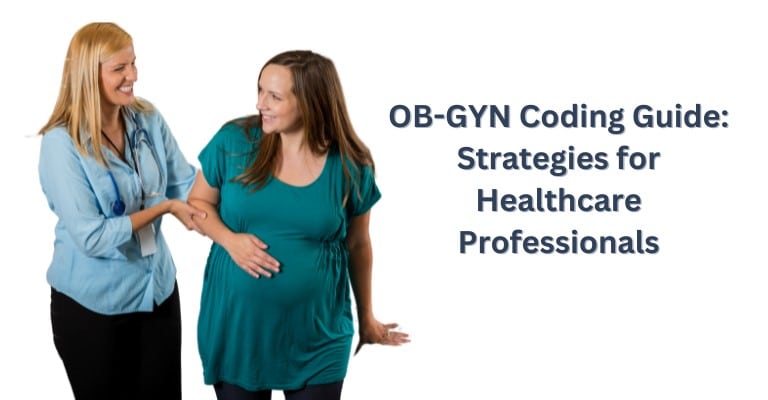
Menu

Accurate OB-GYN coding is important for healthcare providers to receive proper compensation, and remain compliant with regulatory standards. As healthcare continues to evolve staying updated with the latest coding changes and billing techniques is imperative for maintaining a profitable OB-GYN practice.
Efficient coding practices directly impact the revenue cycle of OB-GYN practices by reducing errors that lead to claim denials and delays in payment. This comprehensive guide explores key aspects of OB-GYN coding, from understanding essential CPT codes to applying them correctly in various medical billing scenarios.
The goal is to help medical professionals avoid common pitfalls that, compromise billing efficiency and revenue integrity.
In OB-GYN medical billing, accuracy ensures that healthcare providers are reimbursed correctly. This section explains the importance of the three primary coding systems: CPT, ICD-10, and HCPCS. Thorough knowledge of these codes is crucial for effective billing and ensuring compliance with healthcare regulations.
CPT (Current Procedural Terminology) codes are essential in OB-GYN billing, and documenting the procedures performed. These codes inform insurance providers about the services provided by healthcare professionals, from routine examinations to complex surgeries.
For healthcare providers, precise coding is not just about compliance; it’s a critical component of practice management and financial health. Accurate use of CPT codes ensures that providers are reimbursed for the services they deliver, minimizing delays and denials from insurance companies.
ICD-10 codes specify the patient’s diagnosis and are a fundamental part of the medical billing process. These codes link patient conditions with the procedures performed, justifying the need for treatment. For OB-GYN practices, precise ICD-10 coding is crucial for recording conditions from pregnancy to various gynecological issues, ensuring that claims are supported and less likely to be rejected.
HCPCS (Healthcare Common Procedure Coding System) codes include equipment, supplies, and other services that CPT codes do not cover. This encompasses services like medical devices and additional procedural components critical for OB-GYN services. Proficient use of HCPCS codes is essential for comprehensive billing that reflects the full scope of care provided, improving the accuracy of claims and facilitating appropriate reimbursement.
Accurate OB-GYN coding is critical for effective billing and compliance. This section guides medical billers, coders, and healthcare providers through choosing the right codes to ensure claims are processed efficiently and correctly.
OB-GYN CPT codes are critical for accurate medical billing and documentation in obstetrics and gynecology. This section breaks down key codes and their specific applications to enhance billing accuracy.
Here are some common CPT Codes listed in a table:
| CPT Code | Description | Application in Billing Scenarios |
| 59400 | Routine obstetric care including antepartum care, vaginal delivery, and postpartum care. | Used for a complete OB package from prenatal visits through |
| 58150 | 58150 Total abdominal hysterectomy, including partial vaginectomy. | This applies when a hysterectomy is performed as part of gynecological treatment. |
| 76805 | Ultrasound, pregnant uterus, real-time with image documentation, fetal and maternal evaluation. | Bill for routine mid-pregnancy ultrasound checks. |
| Modifier | Description |
| -25 | Indicates a significant, separately identifiable evaluation and management (E/M) service by the same physician on the day of a procedure. |
| -51 | Use when multiple procedures are performed during the same surgical session by the same provider. |
| -50 | Denotes bilateral procedures when the same procedure is performed on both sides of the body. |
| -59 | Signifies a distinct procedural service that is not normally reported together but is appropriate under the circumstances. |
| -22 | Used when the service(s) provided is greater than that usually required for the listed procedure due to increased intensity, time, or technical difficulty. |
| -62 | Indicates when two surgeons work together as primary surgeons performing distinct parts of a procedure. |
| -79 | Use for an unrelated procedure is performed by the same physician during, the postoperative period of the initial procedure. |
| -24 | Use to report an unrelated E/M service by the same physician during a postoperative period. |
OB-GYN coding is essential for ensuring healthcare providers receive appropriate compensation with regulatory requirements. This section discusses strategies to reduce frequent coding challenges in obstetrics and gynecology.
Prenatal and postnatal care involves detailed and complex coding to ensure that every aspect of care is accurately documented and billed. Here’s how to manage these specifics:
The coding for delivery procedures requires careful attention to detail to differentiate between the types of deliveries and associated complications:
Effective OB-GYN coding ensures proper billing and compliance in medical practices. This section details the best resources to stay updated with the latest coding standards and regulations in the OB-GYN field.
1.Professional Associations
Professional associations play a pivotal role in providing up-to-date information and resources for OB-GYN coding:
2. Online Resources
Keeping online resources is essential for keeping pace with the dynamic field of medical coding:
Accurate and up-to-date OB-GYN coding is essential for the financial stability of healthcare practices. By applying the best practices outlined medical professionals can ensure their billing processes are efficient and compliant, understanding CPT, ICD-10, and HCPCS codes to manage complex billing scenarios. Utilizing the resources and strategies will help prevent common coding errors and improve overall revenue cycle management in OB-GYN practices.
Remember, the key to successful medical billing lies, in continuous learning and adapting to new coding standards.



